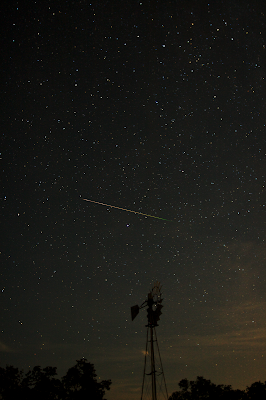It's just occurred to me that I've done my fellow photographers a disservice by not disclosing the photographic details of my recent Perseid meteor photography. That's easily rectified: I used a Canon Digital Rebel XTi (400D) with a Sigma 20mm, f1.8 lens. The camera was set to full-manual mode with the aperture at f1.8, the exposure duration set to 30 seconds, ISO to 400, and capture mode to RAW. It was equipped with an 8 GB storage card, a battery grip (so it had two batteries to draw from), and a shutter cable release that can be locked down such that the camera takes pictures continuously. The lens was set to manual focus, and focused to just shy of infinity. I don't know why, but actually setting the lens to infinity produced out-of-focus stars. So, some experimentation was required to get an acceptable focus. Significantly, the lens was wrapped with a Kendrick FireLite lens warmer powered by a small car battery [my thanks to Chris Cooley for bringing that product to my attention]; without that, even on that summer night in a drought, the lens would have become fogged by dew (my truck was covered with it).
I can easily conceive of better setups (a camera with a full-frame sensor and/or a much wider-angle lens, f1.8 or better), but this setup works, even if the best meteors seem to inevitably fall outside of its field of view.

My second-best meteor photo of the night. ©2009 Chris W. Johnson
12:34:56 AM, August 13, 2009.
Bamberger Ranch Preserve, Blanco County, Texas




